Cookbook #225: Philly Dip Party Handbook, Philadelphia Cream Cheese, circa late 1950s.
 Philly Dip Party Handbook is a paper booklet of cream cheese dip recipes. It’s only 4.5 x 6-inches and 20 pages long. Was it my mother’s? Grandmother’s? I am not sure, as there is no handwriting in this booklet. There is no publication date given, but from web searches, I learned that it was published in the 1950s or 1960s.
Philly Dip Party Handbook is a paper booklet of cream cheese dip recipes. It’s only 4.5 x 6-inches and 20 pages long. Was it my mother’s? Grandmother’s? I am not sure, as there is no handwriting in this booklet. There is no publication date given, but from web searches, I learned that it was published in the 1950s or 1960s.
Each recipe includes Philadelphia Cream Cheese, “famous since 1880” according to the back cover. According to Wikipedia, cream cheese is made from a mixture of milk and cream. Bacteria is added so that the mixture coagulates, then it is heated to kill the bacteria. It is not “naturally matured”, and meant to be eaten fresh. The Wikipedia articls states that it is easy to make at home, but I don’t know anybody who does that! Commercial cream cheese has stablizers added, and sure enough, the package I bought has carob bean gum.
I love cream cheese, but use it sparingly because it is high in calories, 90% of which are fat calories. I haven’t made a dip from cream cheese for ages! Since all of the recipes in this book include cream cheese as the main ingredient, I am just going to have to bite the bullet and make a rich dip. Most of the recipes include a little cream to make the cream cheese more spreadable. Most recipes also include Worcestershire sauce too, and from there, a variety of seasonings and sometimes a protein food (clams, crab, ham).
When I picked up this book to start this blog post, I figured I’d recycle it. But I explored online, and found that it is quite popular. It is for sale on many websites, for example, the etsy site. The booklet goes for as little as 4 dollars and as much as 20 dollars. I guess a lot of people like to collect vintage cookbooks! Some artistic types may also use them for art projects.
Here is a fun blog post about the Philly Dip Party Handbook: Steve Bates in “and everything else too”. He scanned in all 20 pages of the booklet. Steve seems to really enjoy cream cheese dips! A quote: “I’m pretty much set on anything that includes Worcestershire sauce in the ingredients, and since that’s nearly every recipe here, it’s gonna be a tough decision to make cuz OMG they all look amazing!”
I decide to make Philly Clam Dip for this blog. 
Look at the little clam-shaped dish they put the dip in!
I bought Philadelphia brand cream cheese for my dip. It’s in the same grey and blue package as it was in the 1950s.
 I remember with fondness clam dips from my childhood. Often my father would make it, and he always claimed his was clam dip was the “best clam dip ever”. He might have added sour cream to his version. As for me, I’ll make it just like the recipe in the Philly Dip Party Handbook.
I remember with fondness clam dips from my childhood. Often my father would make it, and he always claimed his was clam dip was the “best clam dip ever”. He might have added sour cream to his version. As for me, I’ll make it just like the recipe in the Philly Dip Party Handbook.
- 1 garlic clove, cut in half
- 1 8-ounce package cream cheese
- 1 6.5 ounce ounce can minced clams (drain and reserve the liquid)
- 3 tablespoons clam broth (drained from the clams)
- 2 teaspoons lemon juice
- 1 1/2 teaspoons Worcestershire sauce
- salt and freshly ground pepper to taste
Rub a bowl with the garlic clove. Combine the cream cheese and clam broth in the bowl, blending until smooth. Add the clams, lemon juice. Worcestershire sauce, and salt and pepper, and mix well.
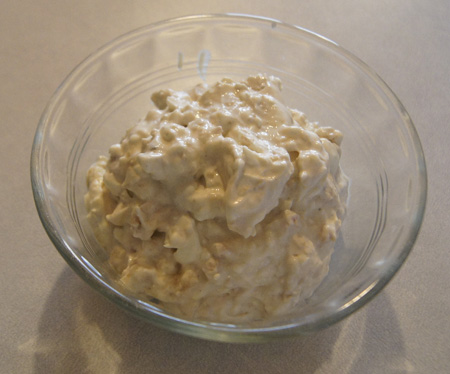
Yum, this was good! And rich. We each took a taste but will save the rest to share with family on Thanksgiving.
The can of minced clams that I had in my cupboard was only 6.5 ounces. I put in most but not all of the package of cream cheese, because I wanted it clam-ier. I had a bottle of clam broth, and I compared it to the clam juice from the can – the clam juice from the can had a lot more flavor. It was salty, though, so I tasted the dip and decided not to add more salt. I have to admit that I didn’t really measure the lemon juice or Worcestershire sauce, I just guessed at the amounts, tasted the dip and added a bit more of each.
A rich, classic clam dip to enjoy!

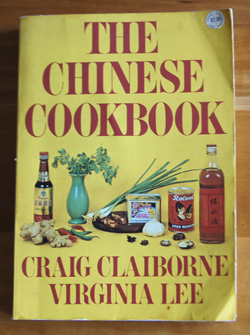 The Chinese Cookbook is one of my favorite cookbooks. I always keep it in my kitchen for ready reference!
The Chinese Cookbook is one of my favorite cookbooks. I always keep it in my kitchen for ready reference!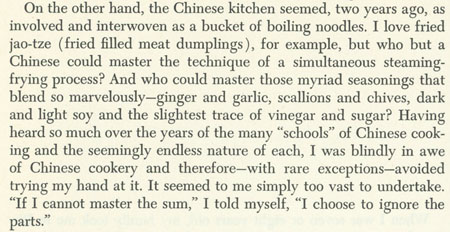 Claiborne goes on to talk about his fourteen year stint as the food news editor and restaurant critic for the New York Times, saying “I was tired. I neeeded rest and a respite from cooking. And then I met Virginia Lee.”
Claiborne goes on to talk about his fourteen year stint as the food news editor and restaurant critic for the New York Times, saying “I was tired. I neeeded rest and a respite from cooking. And then I met Virginia Lee.”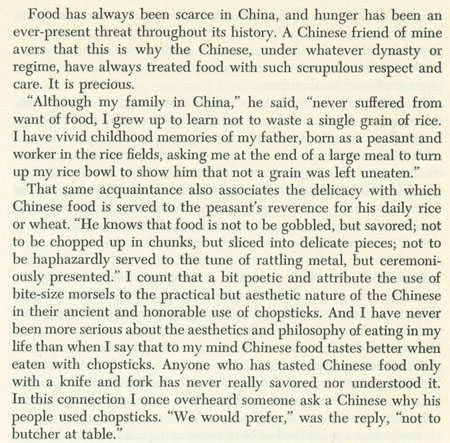 I learned how to make most of my current repertoire of Chinese dishes from The Chinese Cookbook. The recipes are easy to follow, even though the ingredient lists might look daunting with exotic ingredients. For instance, Hot and Sour Soup:
I learned how to make most of my current repertoire of Chinese dishes from The Chinese Cookbook. The recipes are easy to follow, even though the ingredient lists might look daunting with exotic ingredients. For instance, Hot and Sour Soup: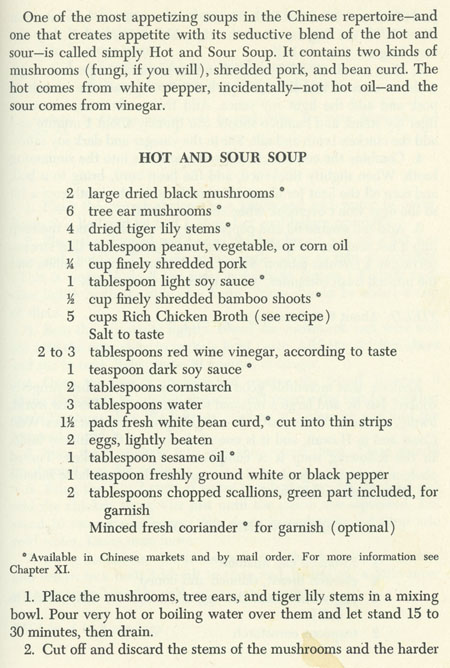
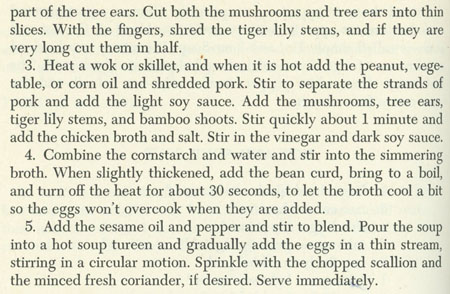 I’ve made this Hot and Sour Soup many times. Dried black mushrooms, tree ear mushrooms, and dried tiger lily stems! Ages ago, I had to go all the way to Denver to a Chinese market to find all of these ingredients. Nowadays I go to the Asian Seafood Market in Boulder. Sometimes I leave out these exotic ingredients, if I have none on hand, or I use fresh shitakes and skip the tree ear and black mushrooms tiger lilies. Not as much fun, but still a good soup.
I’ve made this Hot and Sour Soup many times. Dried black mushrooms, tree ear mushrooms, and dried tiger lily stems! Ages ago, I had to go all the way to Denver to a Chinese market to find all of these ingredients. Nowadays I go to the Asian Seafood Market in Boulder. Sometimes I leave out these exotic ingredients, if I have none on hand, or I use fresh shitakes and skip the tree ear and black mushrooms tiger lilies. Not as much fun, but still a good soup.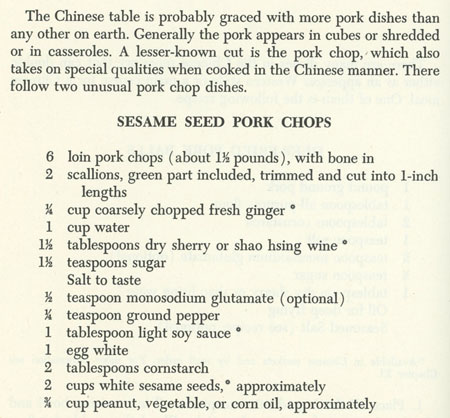
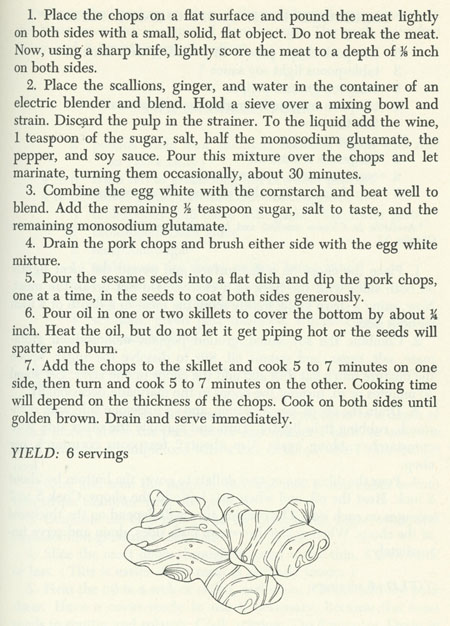 I made these pretty much as per the above recipe, except I left out the monosodium glutamate, and I halved the recipe for two people, but did not halve the amount of egg white/cornstarch mixture. I used bone-in pork sirloin chops, but actually, next time I’d prefer to use boneless pork sirloin.
I made these pretty much as per the above recipe, except I left out the monosodium glutamate, and I halved the recipe for two people, but did not halve the amount of egg white/cornstarch mixture. I used bone-in pork sirloin chops, but actually, next time I’d prefer to use boneless pork sirloin.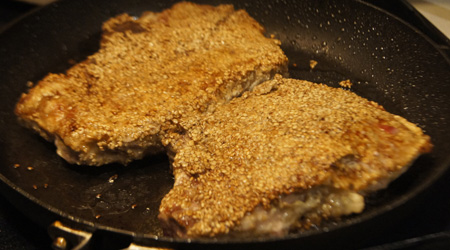 To serve, I sliced the cooked chops into large chunks. It was messy because I had to avoid the bone. But, the pork was very, very juicy and flavorful. I served with fried rice and snow peas and fresh shitakis.
To serve, I sliced the cooked chops into large chunks. It was messy because I had to avoid the bone. But, the pork was very, very juicy and flavorful. I served with fried rice and snow peas and fresh shitakis.